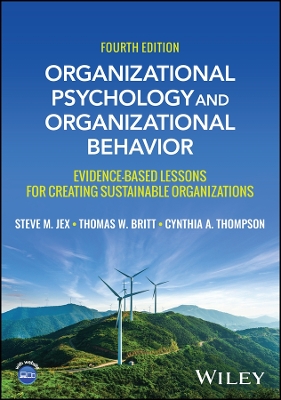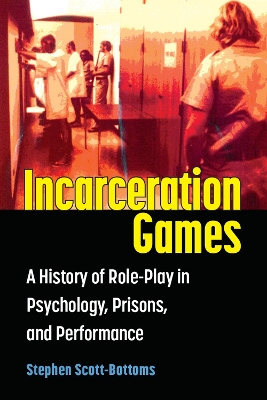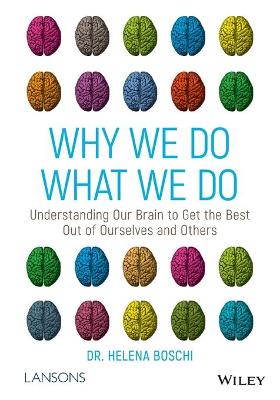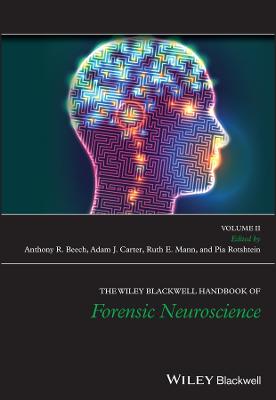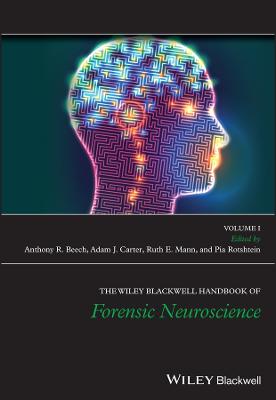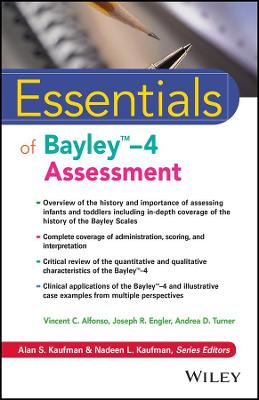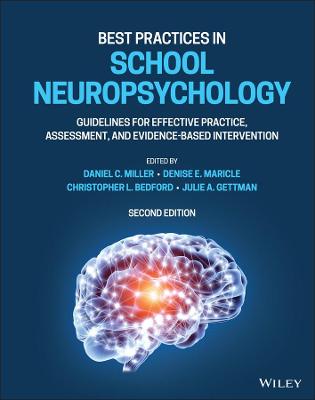Essentials of Cognitive Neuroscience, 2nd Edition
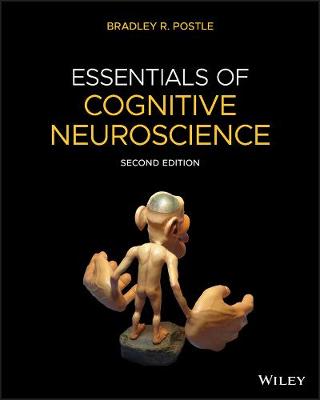 -15%
portes grátis
-15%
portes grátis
Essentials of Cognitive Neuroscience, 2nd Edition
Postle
John Wiley & Sons Inc
05/2020
560
Mole
Inglês
9781119674153
15 a 20 dias
1240
Acknowledgments xix
Walkthrough of Pedagogical Features xxi
Companion Website xxii
Section I: The Neurobiology of Thinking 1
1 Introduction and History 4
Key Themes 4
A Brief (and Selective) History 6
Construct validity in models of cognition 6
Localization of function vs. mass action 7
The first scientifically rigorous demonstrations of localization of function 9
What is a Brain and What Does It Do? 12
Looking Ahead to the Development of Cognitive Neuroscience 13
End-of-Chapter Questions 14
References 14
Other Sources Used 14
Further Reading 15
2 The Brain 16
Key Themes 16
Pep Talk 18
Gross Anatomy 18
The cerebral cortex 21
The Neuron 23
Electrical and chemical properties of the neuron 23
Oscillatory Fluctuations in the Membrane Potential 28
Neurons are never truly "at rest" 28
Oscillatory synchrony 29
Complicated, and Complex 31
End-of-Chapter Questions 32
References 32
Other Sources Used 33
Further Reading 33
3 Methods for Cognitive Neuroscience 34
Key Themes 34
Behavior, Structure, Function, and Models 36
Behavior 36
Neuropsychology, neurophysiology, and the limits of inference 36
Different kinds of neuropsychology address different kinds of questions 37
How does behavior relate to mental functions? 38
Methods for lesioning targeted areas of the brain 39
Nonlocalized trauma 39
Transcranial Neurostimulation 40
The importance of specificity (again) 41
Transcranial magnetic stimulation 43
Anatomy and Cellular Physiology 47
Techniques that exploit the cell biology of the neuron 48
Electrophysiology 51
Invasive recording with microelectrodes: action potentials and local field potentials 51
Electrocorticography 53
Electroencephalography 53
Magnetoencephalography 55
Invasive Neurostimulation 55
Electrical microstimulation 55
Optogenetics 55
Analysis of Time-Varying Signals 56
Event-related analyses 56
Magnetic Resonance Imaging 61
Physics and engineering bases 61
MRI methods for in vivo anatomical imaging 64
Functional magnetic resonance imaging 65
Functional connectivity 70
Resting state functional correlations 70
Magnetic Resonance Spectroscopy 73
Tomography 73
X-ray computed tomography 73
Positron emission tomography 73
Near-Infrared Spectroscopy 76
Some Considerations For Experimental Design 76
Computational Models and Analytic Approaches 78
Neural network modeling 78
Network science and graph theory 82
End-of-Chapter Questions 84
References 85
Other Sources Used 86
Further Reading 86
Section II: Sensation, Perception, Attention, and Action 87
4 Sensation and Perception of Visual Signals 90
Key Themes 90
The Dominant Sense in Primates 92
Organization of the Visual System 92
The visual field 92
The retina and the LGN of the thalamus 92
The retinotopic organization of primary visual cortex 93
The receptive field 95
Information Processing in Primary Visual Cortex - Bottom-Up Feature Detection 96
The V1 neuron as feature detector 96
Columns, hypercolumns, and pinwheels 99
Information Processing in Primary Visual Cortex - Interactivity 100
Feedforward and feedback projections of V1 100
The relation between visual processing and the brain's physiological state 104
Where Does Sensation End? Where Does Perception Begin? 106
End-of-Chapter Questions 106
References 107
Other Sources Used 107
Further Reading 108
5 Audition and Somatosensation 109
Key Themes 109
Apologia 111
Audition 111
Auditory sensation 111
Auditory perception 115
Adieu to audition 119
Somatosensation 119
Transduction of mechanical and thermal energy, and of pain 119
Somatotopy 122
Somatosensory plasticity 126
Phantom limbs and phantom pain 129
Proprioception 131
Adieu to sensation 131
End-of-Chapter Questions 131
References 132
Other Sources Used 132
Further Reading 132
6 The Visual System 134
Key Themes 134
Familiar Principles and Processes, Applied to Higher-Level Representations 136
Two Parallel Pathways 136
A diversity of projections from V1 136
A functional dissociation of visual perception of what an object is vs. where it is located 137
Interconnectedness within and between the two pathways 142
The Organization and Functions of the Ventral Visual Processing Stream 144
Hand cells, face cells, and grandmother cells 144
Broader implications of visual properties of temporal cortex neurons 149
A hierarchy of stimulus representation 150
Object-based (viewpoint-independent) vs. image-based (viewpoint-dependent) representation in IT 153
A critical role for feedback in the ventral visual processing stream 153
Taking Stock 158
End-of-Chapter Questions 158
References 159
Other Sources Used 159
Further Reading 160
7 Spatial Cognition and Attention 161
Key Themes 161
Unilateral Neglect: A Fertile Source of Models of Spatial Cognition and Attention 163
Unilateral neglect: a clinicoanatomical primer 163
Hypotheses arising from clinical observations of neglect 164
The Functional Anatomy of the Dorsal Stream 166
Coordinate transformations to guide action with perception 169
From Parietal Space to Medial-Temporal Place 172
Place cells in the hippocampus 173
How does place come to be represented in the hippocampus? 175
The Neurophysiology of Sensory Attention 175
A day at the circus 176
Attending to locations vs. attending to objects 176
Mechanisms of spatial attention 180
Effects of attention on neuronal activity 181
Turning Our Attention to the Future 185
End-of-Chapter Questions 185
References 186
Other Sources Used 186
Further Reading 187
8 Skeletomotor Control 188
Key Themes 188
The Organization of the Motor System 190
The anatomy of the motor system 190
The corticospinal tract 190
The cortico-cerebellar circuit 190
The cortico-basal ganglia-thalamic circuits 192
Functional Principles of Motor Control 193
The biomechanics of motor control 193
Motor cortex 196
The neurophysiology of movement 196
Motor Control Outside of Motor Cortex 202
Parietal cortex: guiding how we move 202
A neurological dissociation between perceiving objects and acting on them 203
Cerebellum: motor learning, balance, . . . and mental representation? 204
Synaptic plasticity 205
Basal ganglia 206
Cognitive Functions of the Motor System 211
Mirror neurons 212
Holding a mirror up to nature? 213
It's All About Action 214
End-of-Chapter Questions 214
References 215
Other Sources Used 215
Further Reading 216
9 Oculomotor Control and the Control of Attention 218
Key Themes 218
Attention and Action 220
Whys and Hows of Eye Movements 220
Three categories of eye movements 220
The Organization of the Oculomotor System 221
An overview of the circuitry 221
The superior colliculus 222
The posterior system 222
The frontal eye field 223
The supplementary eye field 223
The Control of Eye Movements, and of Attention, In Humans 224
Human oculomotor control 224
Human attentional control 226
The Control of Attention via the Oculomotor System 227
Covert attention 227
Where's the attentional controller? 230
Are Oculomotor Control and Attentional Control Really the "Same Thing"? 233
The "method of visual inspection" 234
"Prioritized maps of space in human frontoparietal cortex" 235
Of Labels and Mechanisms 238
End-of-Chapter Questions 238
References 238
Other Sources Used 239
Further Reading 240
Section III: Mental Representation 241
10 Visual Object Recognition and Knowledge 243
Key Themes 243
Visual Agnosia 245
Apperceptive agnosia 245
Associative agnosia 245
Computational Models of Visual Object Recognition 247
Two neuropsychological traditions 247
The cognitive neuroscience revolution in visual cognition 249
Category Specificity in the Ventral Stream? 249
Are faces special? 249
Perceptual expertise 251
Evidence for a high degree of specificity for many categories in ventral occipitotemporal cortex 252
Evidence for highly distributed category representation in ventral occipitotemporal cortex 253
Demonstrating necessity 256
The code for facial identity in the primate brain (!?!) 258
Visual Perception as Predictive Coding 261
Playing 20 Questions With the Brain 262
End-of-Chapter Questions 264
References 264
Other Sources Used 265
Further Reading 265
11 Neural Bases of Memory 267
Key Themes 267
Plasticity, Learning, and Memory 269
The Case of H.M. 269
Bilateral medial temporal lobectomy 269
Hippocampus vs. MTL? 272
Association Through Synaptic Modification 273
Long-term potentiation 273
The necessity of NMDA channels for LTM formation 277
How Might the Hippocampus Work? 277
Fast-encoding hippocampus vs. slow-encoding cortex 278
Episodic memory for sequences 279
Episodic memory as an evolutionary elaboration of navigational processing 282
What Are the Cognitive Functions of the Hippocampus? 283
Standard anatomical model 283
Challenges to the standard anatomical model 283
Consolidation 285
Reconsolidation 286
To Consolidate 286
End-of-Chapter Questions 288
References 288
Other Sources Used 289
Further Reading 290
12 Declarative Long-Term Memory 291
Key Themes 291
The Cognitive Neuroscience of LTM 293
Encoding 293
Neuroimaging the hippocampus 293
Incidental encoding into LTM during a short-term memory task 296
The Hippocampus in Spatial Memory Experts 299
Retrieval 299
Retrieval without awareness 300
Documenting contextual reinstatement in the brain 301
Familiarity vs. recollection 303
Knowledge 306
End-of-Chapter Questions 306
References 307
Other Sources Used 308
Further Reading 308
13 Semantic Long-Term Memory 310
Key Themes 310
Knowledge in the Brain 312
Definitions and Basic Facts 312
Category-Specific Deficits Following Brain Damage 313
Animacy, or function? 313
A PDP model of modality specificity 314
The domain-specific knowledge hypothesis 314
How definitive is a single case study? A double dissociation? 315
The Neuroimaging of Knowledge 316
The meaning, and processing, of words 316
An aside about the role of language in semantics and the study of semantics 316
PET scanning of object knowledge 317
Knowledge retrieval or lexical access? 318
Repetition effects and fMRI adaptation 319
The Progressive Loss of Knowledge 321
Primary Progressive Aphasia or Semantic Dementia, Nonverbal deficits in fluent primary progressive aphasia? 322
The locus of damage in fluent primary progressive aphasia? 322
Distal effects of neurodegeneration 324
Entente cordiale 324
Nuance and Challenges 326
End-of-Chapter Questions 326
References 327
Other Sources Used 328
Further Reading 329
14 Working Memory 330
Key Themes 330
"Prolonged Perception" Or "Activated LTM?" 332
Definitions 332
Working Memory and the PFC? The Roots of a Long and Fraught Association 333
Early focus on role of PFC in the control of STM 334
Single-unit delay-period activity in PFC and thalamus 335
Working Memory Capacity and Contralateral Delay Activity 342
The electrophysiology of visual working memory capacity 343
Novel Insights From Multivariate Data Analysis 349
The tradition of univariate analyses 349
MVPA of fMRI 349
Retrospective MVPA of single-unit extracellular recordings 356
Activity? Who Needs Activity? 357
Four-Score and a Handful of Years (and Counting) 360
End-of-Chapter Questions 360
References 360
Other Sources Used 362
Further Reading 362
Section IV: High-Level Cognition 363
15 Cognitive Control 365
Key Themes 365
The Lateral Frontal-Lobe Syndrome 367
Environmental-dependency syndrome 367
Perseveration 368
Electrophysiology of the frontal-lobe syndrome 370
Integration? 371
Models of Cognitive Control 371
Developmental cognitive neuroscience 371
Generalizing beyond development 374
What makes the PFC special? 375
Influence of the DA reward signal on the functions of PFC 376
Neural Activity Relating to Cognitive Control 378
Error monitoring 378
Going Meta 386
Where is the controller? 388
End-of-Chapter Questions 389
References 389
Other Sources Used 390
Further Reading 391
16 Decision Making 392
Key Themes 392
Between Perception and Action 394
Perceptual Decision Making 394
Judging the direction of motion 394
LIP 396
Modeling perceptual decision making 396
Controversy and complications 399
Perceptual decision making in humans 401
Value-Based Decision Making 402
The influence of expected value on activity in LIP 403
Common currency in the omPFC 404
Has neuroeconomics taught us anything about the economics of decision making? 409
Foraging 410
Boys being boys 411
Peer pressure 411
Next Stop 412
End-of-Chapter Questions 412
References 412
Other Sources Used 413
Further Reading 414
17 Social Behavior 415
Key Themes 415
Trustworthiness: A Preamble 417
Delaying gratification: a social influence on a "frontal" class of behaviors 417
The Role of vmPFC in the Control of Social Cognition 418
Phineas Gage 418
Contemporary behavioral neurology 420
Theory of Mind 422
The ToM network 422
The temporoparietal junction (TPJ) 423
False beliefs (?) about Rebecca Saxe's mind 425
A final assessment of the role of RTPJ in ToM mentalization 429
Observational Learning 430
Predicting the outcome of someone else's actions 430
Trustworthiness, Revisited 435
End-of-Chapter Questions 435
References 436
Other Sources Used 437
Further Reading 437
18 Emotion 438
Key Themes 438
What is an Emotion? 440
Approach/withdrawal 440
From "feeling words" to neural systems 440
At the nexus of perception and social cognition 440
Trustworthiness Revisited - Again 440
A role for the amygdala in the processing of trustworthiness 441
Implicit information processing by the amygdala 443
The Amygdala 444
Kluever-Bucy syndrome 444
Pavlovian fear conditioning 444
Emotional content in declarative memories 446
The amygdala's influence on other brain systems 449
The Control of Emotions 450
Extinction 450
How Does That Make You Feel? 455
End-of-Chapter Questions 457
References 458
Other Sources Used 458
Further Reading 459
19 Language 460
Key Themes 460
A System of Remarkable Complexity 462
Wernicke-Lichtheim: The Classical Core Language Network 462
The aphasias 462
The functional relevance of the connectivity of the network 463
Speech Perception 464
Segregation of the speech signal 464
Dual routes for speech processing 468
Grammar 469
Genetics 469
Rules in the brain? 471
Broca's area 472
The electrophysiology of grammar 475
Speech Production 477
A psycholinguistic model of production 477
Forward models for the control of production 477
Prediction 479
Integration 480
End-of-Chapter Questions 481
References 481
Other Sources Used 483
Further Reading 483
20 Consciousness 485
Key Themes 485
The Most Complex Object in the Universe 487
Different Approaches to the Problem 487
The Physiology of Consciousness 488
Neurological syndromes 488
Sleep 492
Anesthesia 494
Summary across physiological studies 495
Brain Functions Supporting Conscious Perception 495
Are we conscious of activity in early sensory cortex? 497
Manipulating extrinsic factors to study conscious vs. unconscious vision 500
Are Attention and Awareness the Same Thing? 501
Theories of Consciousness 503
Global Workspace Theory 503
Recurrent Processing Theory 505
Integrated Information Theory 506
Updating the Consciousness Graph 508
End-of-Chapter Questions 509
References 509
Other Sources Used 511
Further Reading 511
Glossary G-1
Index I-1
Acknowledgments xix
Walkthrough of Pedagogical Features xxi
Companion Website xxii
Section I: The Neurobiology of Thinking 1
1 Introduction and History 4
Key Themes 4
A Brief (and Selective) History 6
Construct validity in models of cognition 6
Localization of function vs. mass action 7
The first scientifically rigorous demonstrations of localization of function 9
What is a Brain and What Does It Do? 12
Looking Ahead to the Development of Cognitive Neuroscience 13
End-of-Chapter Questions 14
References 14
Other Sources Used 14
Further Reading 15
2 The Brain 16
Key Themes 16
Pep Talk 18
Gross Anatomy 18
The cerebral cortex 21
The Neuron 23
Electrical and chemical properties of the neuron 23
Oscillatory Fluctuations in the Membrane Potential 28
Neurons are never truly "at rest" 28
Oscillatory synchrony 29
Complicated, and Complex 31
End-of-Chapter Questions 32
References 32
Other Sources Used 33
Further Reading 33
3 Methods for Cognitive Neuroscience 34
Key Themes 34
Behavior, Structure, Function, and Models 36
Behavior 36
Neuropsychology, neurophysiology, and the limits of inference 36
Different kinds of neuropsychology address different kinds of questions 37
How does behavior relate to mental functions? 38
Methods for lesioning targeted areas of the brain 39
Nonlocalized trauma 39
Transcranial Neurostimulation 40
The importance of specificity (again) 41
Transcranial magnetic stimulation 43
Anatomy and Cellular Physiology 47
Techniques that exploit the cell biology of the neuron 48
Electrophysiology 51
Invasive recording with microelectrodes: action potentials and local field potentials 51
Electrocorticography 53
Electroencephalography 53
Magnetoencephalography 55
Invasive Neurostimulation 55
Electrical microstimulation 55
Optogenetics 55
Analysis of Time-Varying Signals 56
Event-related analyses 56
Magnetic Resonance Imaging 61
Physics and engineering bases 61
MRI methods for in vivo anatomical imaging 64
Functional magnetic resonance imaging 65
Functional connectivity 70
Resting state functional correlations 70
Magnetic Resonance Spectroscopy 73
Tomography 73
X-ray computed tomography 73
Positron emission tomography 73
Near-Infrared Spectroscopy 76
Some Considerations For Experimental Design 76
Computational Models and Analytic Approaches 78
Neural network modeling 78
Network science and graph theory 82
End-of-Chapter Questions 84
References 85
Other Sources Used 86
Further Reading 86
Section II: Sensation, Perception, Attention, and Action 87
4 Sensation and Perception of Visual Signals 90
Key Themes 90
The Dominant Sense in Primates 92
Organization of the Visual System 92
The visual field 92
The retina and the LGN of the thalamus 92
The retinotopic organization of primary visual cortex 93
The receptive field 95
Information Processing in Primary Visual Cortex - Bottom-Up Feature Detection 96
The V1 neuron as feature detector 96
Columns, hypercolumns, and pinwheels 99
Information Processing in Primary Visual Cortex - Interactivity 100
Feedforward and feedback projections of V1 100
The relation between visual processing and the brain's physiological state 104
Where Does Sensation End? Where Does Perception Begin? 106
End-of-Chapter Questions 106
References 107
Other Sources Used 107
Further Reading 108
5 Audition and Somatosensation 109
Key Themes 109
Apologia 111
Audition 111
Auditory sensation 111
Auditory perception 115
Adieu to audition 119
Somatosensation 119
Transduction of mechanical and thermal energy, and of pain 119
Somatotopy 122
Somatosensory plasticity 126
Phantom limbs and phantom pain 129
Proprioception 131
Adieu to sensation 131
End-of-Chapter Questions 131
References 132
Other Sources Used 132
Further Reading 132
6 The Visual System 134
Key Themes 134
Familiar Principles and Processes, Applied to Higher-Level Representations 136
Two Parallel Pathways 136
A diversity of projections from V1 136
A functional dissociation of visual perception of what an object is vs. where it is located 137
Interconnectedness within and between the two pathways 142
The Organization and Functions of the Ventral Visual Processing Stream 144
Hand cells, face cells, and grandmother cells 144
Broader implications of visual properties of temporal cortex neurons 149
A hierarchy of stimulus representation 150
Object-based (viewpoint-independent) vs. image-based (viewpoint-dependent) representation in IT 153
A critical role for feedback in the ventral visual processing stream 153
Taking Stock 158
End-of-Chapter Questions 158
References 159
Other Sources Used 159
Further Reading 160
7 Spatial Cognition and Attention 161
Key Themes 161
Unilateral Neglect: A Fertile Source of Models of Spatial Cognition and Attention 163
Unilateral neglect: a clinicoanatomical primer 163
Hypotheses arising from clinical observations of neglect 164
The Functional Anatomy of the Dorsal Stream 166
Coordinate transformations to guide action with perception 169
From Parietal Space to Medial-Temporal Place 172
Place cells in the hippocampus 173
How does place come to be represented in the hippocampus? 175
The Neurophysiology of Sensory Attention 175
A day at the circus 176
Attending to locations vs. attending to objects 176
Mechanisms of spatial attention 180
Effects of attention on neuronal activity 181
Turning Our Attention to the Future 185
End-of-Chapter Questions 185
References 186
Other Sources Used 186
Further Reading 187
8 Skeletomotor Control 188
Key Themes 188
The Organization of the Motor System 190
The anatomy of the motor system 190
The corticospinal tract 190
The cortico-cerebellar circuit 190
The cortico-basal ganglia-thalamic circuits 192
Functional Principles of Motor Control 193
The biomechanics of motor control 193
Motor cortex 196
The neurophysiology of movement 196
Motor Control Outside of Motor Cortex 202
Parietal cortex: guiding how we move 202
A neurological dissociation between perceiving objects and acting on them 203
Cerebellum: motor learning, balance, . . . and mental representation? 204
Synaptic plasticity 205
Basal ganglia 206
Cognitive Functions of the Motor System 211
Mirror neurons 212
Holding a mirror up to nature? 213
It's All About Action 214
End-of-Chapter Questions 214
References 215
Other Sources Used 215
Further Reading 216
9 Oculomotor Control and the Control of Attention 218
Key Themes 218
Attention and Action 220
Whys and Hows of Eye Movements 220
Three categories of eye movements 220
The Organization of the Oculomotor System 221
An overview of the circuitry 221
The superior colliculus 222
The posterior system 222
The frontal eye field 223
The supplementary eye field 223
The Control of Eye Movements, and of Attention, In Humans 224
Human oculomotor control 224
Human attentional control 226
The Control of Attention via the Oculomotor System 227
Covert attention 227
Where's the attentional controller? 230
Are Oculomotor Control and Attentional Control Really the "Same Thing"? 233
The "method of visual inspection" 234
"Prioritized maps of space in human frontoparietal cortex" 235
Of Labels and Mechanisms 238
End-of-Chapter Questions 238
References 238
Other Sources Used 239
Further Reading 240
Section III: Mental Representation 241
10 Visual Object Recognition and Knowledge 243
Key Themes 243
Visual Agnosia 245
Apperceptive agnosia 245
Associative agnosia 245
Computational Models of Visual Object Recognition 247
Two neuropsychological traditions 247
The cognitive neuroscience revolution in visual cognition 249
Category Specificity in the Ventral Stream? 249
Are faces special? 249
Perceptual expertise 251
Evidence for a high degree of specificity for many categories in ventral occipitotemporal cortex 252
Evidence for highly distributed category representation in ventral occipitotemporal cortex 253
Demonstrating necessity 256
The code for facial identity in the primate brain (!?!) 258
Visual Perception as Predictive Coding 261
Playing 20 Questions With the Brain 262
End-of-Chapter Questions 264
References 264
Other Sources Used 265
Further Reading 265
11 Neural Bases of Memory 267
Key Themes 267
Plasticity, Learning, and Memory 269
The Case of H.M. 269
Bilateral medial temporal lobectomy 269
Hippocampus vs. MTL? 272
Association Through Synaptic Modification 273
Long-term potentiation 273
The necessity of NMDA channels for LTM formation 277
How Might the Hippocampus Work? 277
Fast-encoding hippocampus vs. slow-encoding cortex 278
Episodic memory for sequences 279
Episodic memory as an evolutionary elaboration of navigational processing 282
What Are the Cognitive Functions of the Hippocampus? 283
Standard anatomical model 283
Challenges to the standard anatomical model 283
Consolidation 285
Reconsolidation 286
To Consolidate 286
End-of-Chapter Questions 288
References 288
Other Sources Used 289
Further Reading 290
12 Declarative Long-Term Memory 291
Key Themes 291
The Cognitive Neuroscience of LTM 293
Encoding 293
Neuroimaging the hippocampus 293
Incidental encoding into LTM during a short-term memory task 296
The Hippocampus in Spatial Memory Experts 299
Retrieval 299
Retrieval without awareness 300
Documenting contextual reinstatement in the brain 301
Familiarity vs. recollection 303
Knowledge 306
End-of-Chapter Questions 306
References 307
Other Sources Used 308
Further Reading 308
13 Semantic Long-Term Memory 310
Key Themes 310
Knowledge in the Brain 312
Definitions and Basic Facts 312
Category-Specific Deficits Following Brain Damage 313
Animacy, or function? 313
A PDP model of modality specificity 314
The domain-specific knowledge hypothesis 314
How definitive is a single case study? A double dissociation? 315
The Neuroimaging of Knowledge 316
The meaning, and processing, of words 316
An aside about the role of language in semantics and the study of semantics 316
PET scanning of object knowledge 317
Knowledge retrieval or lexical access? 318
Repetition effects and fMRI adaptation 319
The Progressive Loss of Knowledge 321
Primary Progressive Aphasia or Semantic Dementia, Nonverbal deficits in fluent primary progressive aphasia? 322
The locus of damage in fluent primary progressive aphasia? 322
Distal effects of neurodegeneration 324
Entente cordiale 324
Nuance and Challenges 326
End-of-Chapter Questions 326
References 327
Other Sources Used 328
Further Reading 329
14 Working Memory 330
Key Themes 330
"Prolonged Perception" Or "Activated LTM?" 332
Definitions 332
Working Memory and the PFC? The Roots of a Long and Fraught Association 333
Early focus on role of PFC in the control of STM 334
Single-unit delay-period activity in PFC and thalamus 335
Working Memory Capacity and Contralateral Delay Activity 342
The electrophysiology of visual working memory capacity 343
Novel Insights From Multivariate Data Analysis 349
The tradition of univariate analyses 349
MVPA of fMRI 349
Retrospective MVPA of single-unit extracellular recordings 356
Activity? Who Needs Activity? 357
Four-Score and a Handful of Years (and Counting) 360
End-of-Chapter Questions 360
References 360
Other Sources Used 362
Further Reading 362
Section IV: High-Level Cognition 363
15 Cognitive Control 365
Key Themes 365
The Lateral Frontal-Lobe Syndrome 367
Environmental-dependency syndrome 367
Perseveration 368
Electrophysiology of the frontal-lobe syndrome 370
Integration? 371
Models of Cognitive Control 371
Developmental cognitive neuroscience 371
Generalizing beyond development 374
What makes the PFC special? 375
Influence of the DA reward signal on the functions of PFC 376
Neural Activity Relating to Cognitive Control 378
Error monitoring 378
Going Meta 386
Where is the controller? 388
End-of-Chapter Questions 389
References 389
Other Sources Used 390
Further Reading 391
16 Decision Making 392
Key Themes 392
Between Perception and Action 394
Perceptual Decision Making 394
Judging the direction of motion 394
LIP 396
Modeling perceptual decision making 396
Controversy and complications 399
Perceptual decision making in humans 401
Value-Based Decision Making 402
The influence of expected value on activity in LIP 403
Common currency in the omPFC 404
Has neuroeconomics taught us anything about the economics of decision making? 409
Foraging 410
Boys being boys 411
Peer pressure 411
Next Stop 412
End-of-Chapter Questions 412
References 412
Other Sources Used 413
Further Reading 414
17 Social Behavior 415
Key Themes 415
Trustworthiness: A Preamble 417
Delaying gratification: a social influence on a "frontal" class of behaviors 417
The Role of vmPFC in the Control of Social Cognition 418
Phineas Gage 418
Contemporary behavioral neurology 420
Theory of Mind 422
The ToM network 422
The temporoparietal junction (TPJ) 423
False beliefs (?) about Rebecca Saxe's mind 425
A final assessment of the role of RTPJ in ToM mentalization 429
Observational Learning 430
Predicting the outcome of someone else's actions 430
Trustworthiness, Revisited 435
End-of-Chapter Questions 435
References 436
Other Sources Used 437
Further Reading 437
18 Emotion 438
Key Themes 438
What is an Emotion? 440
Approach/withdrawal 440
From "feeling words" to neural systems 440
At the nexus of perception and social cognition 440
Trustworthiness Revisited - Again 440
A role for the amygdala in the processing of trustworthiness 441
Implicit information processing by the amygdala 443
The Amygdala 444
Kluever-Bucy syndrome 444
Pavlovian fear conditioning 444
Emotional content in declarative memories 446
The amygdala's influence on other brain systems 449
The Control of Emotions 450
Extinction 450
How Does That Make You Feel? 455
End-of-Chapter Questions 457
References 458
Other Sources Used 458
Further Reading 459
19 Language 460
Key Themes 460
A System of Remarkable Complexity 462
Wernicke-Lichtheim: The Classical Core Language Network 462
The aphasias 462
The functional relevance of the connectivity of the network 463
Speech Perception 464
Segregation of the speech signal 464
Dual routes for speech processing 468
Grammar 469
Genetics 469
Rules in the brain? 471
Broca's area 472
The electrophysiology of grammar 475
Speech Production 477
A psycholinguistic model of production 477
Forward models for the control of production 477
Prediction 479
Integration 480
End-of-Chapter Questions 481
References 481
Other Sources Used 483
Further Reading 483
20 Consciousness 485
Key Themes 485
The Most Complex Object in the Universe 487
Different Approaches to the Problem 487
The Physiology of Consciousness 488
Neurological syndromes 488
Sleep 492
Anesthesia 494
Summary across physiological studies 495
Brain Functions Supporting Conscious Perception 495
Are we conscious of activity in early sensory cortex? 497
Manipulating extrinsic factors to study conscious vs. unconscious vision 500
Are Attention and Awareness the Same Thing? 501
Theories of Consciousness 503
Global Workspace Theory 503
Recurrent Processing Theory 505
Integrated Information Theory 506
Updating the Consciousness Graph 508
End-of-Chapter Questions 509
References 509
Other Sources Used 511
Further Reading 511
Glossary G-1
Index I-1



